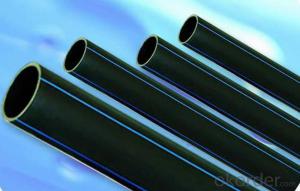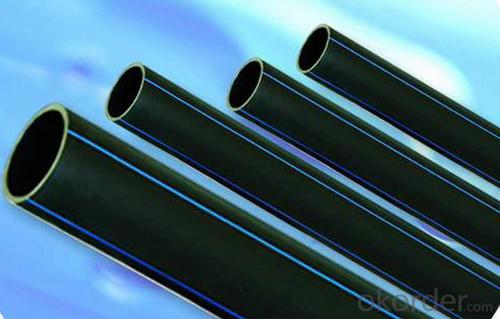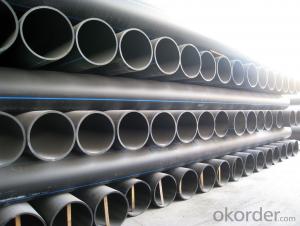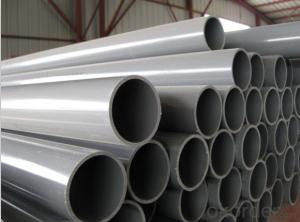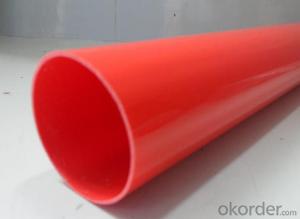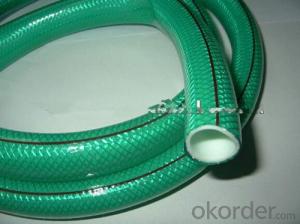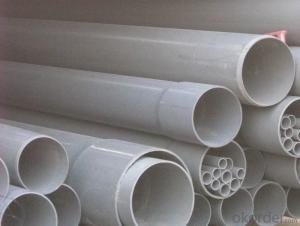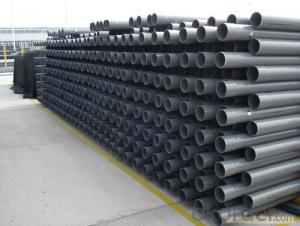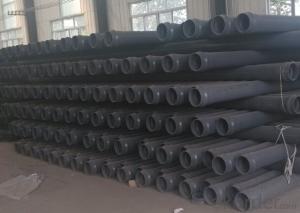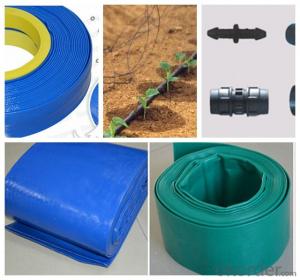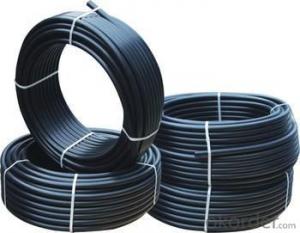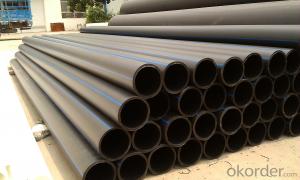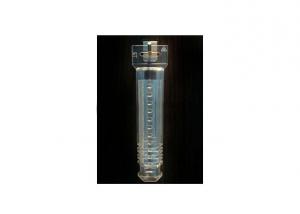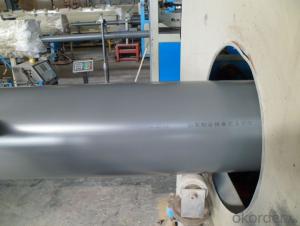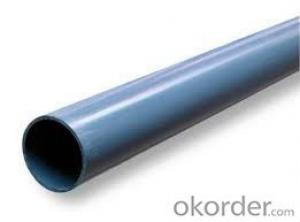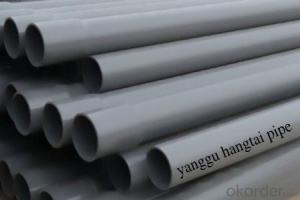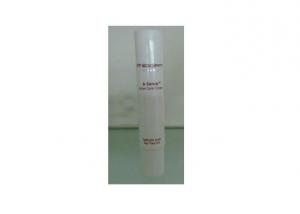Plastic Tubes HDPE Pipe ISO4427-2000
- Loading Port:
- China Main Port
- Payment Terms:
- TT OR LC
- Min Order Qty:
- -
- Supply Capability:
- -
OKorder Service Pledge
OKorder Financial Service
You Might Also Like
Physical properties[edit]
Polyethylene is a thermoplasticpolymer consisting of long hydrocarbon chains. Depending on the crystallinity and molecular weight, a melting point and glass transition may or may not be observable. The temperature at which these occur varies strongly with the type of polyethylene. For common commercial grades of medium- and high-density polyethylene the melting point is typically in the range 120 to 180 °C (248 to 356 °F). The melting point for average, commercial, low-density polyethylene is typically 105 to 115 °C (221 to 239 °F).it is transprant.
Chemical properties[edit]
Most LDPE, MDPE and HDPE grades have excellent chemical resistance, meaning that it is not attacked by strong acids or strong bases. It is also resistant to gentle oxidants and reducing agents. Polyethylene burns slowly with a blue flame having a yellow tip and gives off an odour of paraffin. The material continues burning on removal of the flame source and produces a drip.[3] Crystalline samples do not dissolve at room temperature. Polyethylene (other than cross-linked polyethylene) usually can be dissolved at elevated temperatures in aromatic hydrocarbons such as toluene or xylene, or in chlorinated solvents such as trichloroethane or trichlorobenzene.[4]
GB/T13663-2000:
| PE63管材规格 | |||||
| 公称 外径dn,mm | SDR33 | SDR26 | SDR17.6 | SDR13.6 | SDR11 |
| 公称压力 PN,Mpa | |||||
| 0.32 | 0.4 | 0.6 | 0.8 | 1.0 | |
| 公称 壁厚 | 公称 壁厚 | 公称 壁厚 | 公称 壁厚 | 公称 壁厚 | |
| 16 | 2.3 | ||||
| 20 | 2.3 | 2.3 | |||
| 25 | 2.3 | 2.3 | 2.3 | ||
| 32 | 2.3 | 2.4 | 2.9 | ||
| 40 | 2.3 | 2.3 | 3.0 | 3.7 | |
| 50 | 2.3 | 2.9 | 3.7 | 4.6 | |
| 63 | 2.3 | 2.5 | 3.6 | 4.7 | 5.8 |
| 75 | 2.3 | 2.9 | 4.3 | 5.6 | 6.8 |
| 90 | 2.8 | 3.5 | 5.1 | 6.7 | 8.2 |
| 110 | 3.4 | 4.2 | 6.3 | 8.1 | 10.0 |
| 125 | 3.9 | 4.8 | 7.1 | 9.2 | 11.4 |
| 140 | 4.3 | 5.4 | 8.0 | 10.3 | 12.7 |
| 160 | 4.9 | 6.2 | 9.1 | 11.8 | 14.6 |
| 180 | 5.5 | 6.9 | 10.2 | 13.3 | 16.4 |
| 200 | 6.2 | 7.7 | 11.4 | 14.7 | 18.2 |
| 225 | 6.9 | 8.6 | 12.8 | 16.6 | 20.5 |
| 250 | 7.7 | 9.6 | 14.2 | 18.4 | 22.7 |
| 280 | 8.6 | 10.7 | 15.9 | 20.6 | 25.4 |
| 315 | 9.7 | 12.1 | 17.9 | 23.2 | 28.6 |
| 355 | 10.9 | 13.6 | 20.1 | 26.1 | 32.2 |
| 400 | 12.3 | 15.3 | 22.7 | 29.4 | 36.3 |
| 450 | 13.8 | 17.2 | 25.5 | 33.1 | 40.9 |
| 500 | 15.3 | 19.1 | 28.3 | 36.8 | 45.4 |
| 560 | 17.2 | 21.4 | 31.7 | 41.2 | 50.8 |
| 630 | 19.3 | 24.1 | 35.7 | 46.3 | 57.2 |
- Q: What are the different closure options for plastic tubes?
- Some of the different closure options for plastic tubes include screw caps, flip-top caps, snap-on caps, squeeze caps, and pump dispensers.
- Q: Purified water production pipeline, which can be used plastic pipes, which use steel pipe?
- Tap water to the water tank can be made of plastic pipe (PVC pipe), from raw water to multi medium filter (sand filter) can be made of plastic pipe, from the multi medium filter to the activated carbon filter part can be made of plastic pipe, the rest with a pipe, from the activated carbon filter to the softening part can be made of plastic pipe the rest with a pipe, from the softener to reverse osmosis part with a plastic pipe, steel pipe for rest. All purified water contact lines must be 316L stainless steel, but in some places they can be connected by hose.
- Q: How do plastic tubes compare to nylon tubes in terms of strength?
- Plastic tubes generally have lower strength compared to nylon tubes. Nylon tubes are known for their superior strength, durability, and resistance to wear and tear. They can withstand higher pressures and have better tensile strength, making them more suitable for applications requiring high performance and reliability.
- Q: Can plastic tubes be used for food and beverage applications?
- Yes, plastic tubes can be used for food and beverage applications.
- Q: i wanna breed them i have a female in a 15 qt tub and im worried she will chew through it after seeing some question on here about that being answered that they will chew through it but when i look on youtube i see people breeding them in plastic tubes and stuff so whats the deal i figured if they do why would these breeders use them can somebody plz hlp or have any suggestions
- Mice generally won't chew through plastic unless they have nothing else to chew. Just provide a (safe) piece of wood, or something similar, and they'll be fine! Please don't breed them unless you: -know that the mouse is the correct age -know that the mouse doesn't have any health issues -have GOOD homes for the 20+ babies, ie. only sell them IF the buyers are good with pets and they know how to look after mice -are prepared for the high possibility that the mum will die, and that some (or possibly all) of the babies will die too -know exactly how to breed them (do LOADS of research first).
- Q: What are the types of plastic pipes?
- Chlorinated polyvinyl chloride pipe is a new kind of water supply pipe made of chlorinated polyvinyl chloride resin. Its biggest advantage is that it is more resistant to high temperature. This pipe application in China just started in recent years, is used in cold water and waste water, chemical solution conveying pipeline, long-term use of infusion temperature up to 120 degrees Celsius, life for 40 years.
- Q: How do plastic tubes perform in high-altitude environments?
- Plastic tubes generally perform well in high-altitude environments due to their lightweight and durable nature. However, their performance can vary depending on factors such as temperature fluctuations, pressure changes, and exposure to UV radiation. It is important to choose appropriate materials and designs that can withstand these conditions and prevent any potential degradation or failure.
- Q: My little brother just got 2 gerbils. One of them is fine going in the tubes and coming back down, but the other won't go up. He will climb down if you put him up there, but he won't climb up on his own. Their sleeping area is on the top floor, and there's another floor with his food and water on it. The water bottle will only fit in that spot, so there's no other way to move the bottle. Also, how do i get them to figure out how to use a water bottle?
- Until your gerbil gets the hang of it, put the food on the level he does have access to. At times all it takes is a little time for them to realize there's more to their home. Once he does, he'll be able to have the food where it currently is. I do wish to make sure you know that gerbils do chew through plastic and make quick work of tubes and tunnels. Within a couple weeks there could be a hole large enough for him to get out. Please just keep an eye on him to make sure he's not chewing on it. If he is, you may want to put him in a safer cage. I've seen many gerbils chew through the Critter Trail cages and many distraught owners wondering how to find their gerbils once they have escaped. Many owners don't feel their gerbil is a chewer or that the plastic is thick enough, but never underestimate the power of their determination and jaws. Many will chew through it, it simply ends up being a matter of when. Then again, some are fine, but in my own experience with gerbil parents, their gerbils all found a way out. My own two included (though I had been watching and as soon as I found the possibility of them making it out, they were immediately switched to a safer cage).
- Q: Can plastic tubes be used for personal care products?
- Yes, plastic tubes can be used for personal care products. They are commonly used for packaging and dispensing various personal care items such as toothpaste, lotions, creams, gels, and serums. Plastic tubes are lightweight, durable, and offer convenient and hygienic application of these products.
- Q: How do plastic tubes compare to silicone tubing?
- Plastic tubes and silicone tubing have distinct differences in terms of their properties and applications. Plastic tubes are generally more rigid and less flexible compared to silicone tubing. They are commonly used for structural purposes and in industries where rigidity and durability are crucial, such as plumbing and construction. Silicone tubing, on the other hand, offers excellent flexibility, high temperature resistance, and biocompatibility, making it ideal for applications in medical devices, food and beverage industries, and laboratory settings. Ultimately, the choice between plastic tubes and silicone tubing depends on the specific requirements and intended use of the tubing.
Send your message to us
Plastic Tubes HDPE Pipe ISO4427-2000
- Loading Port:
- China Main Port
- Payment Terms:
- TT OR LC
- Min Order Qty:
- -
- Supply Capability:
- -
OKorder Service Pledge
OKorder Financial Service
Similar products
Hot products
Hot Searches
Related keywords
